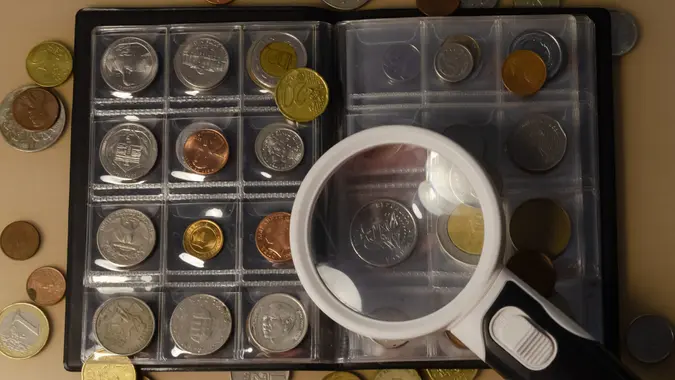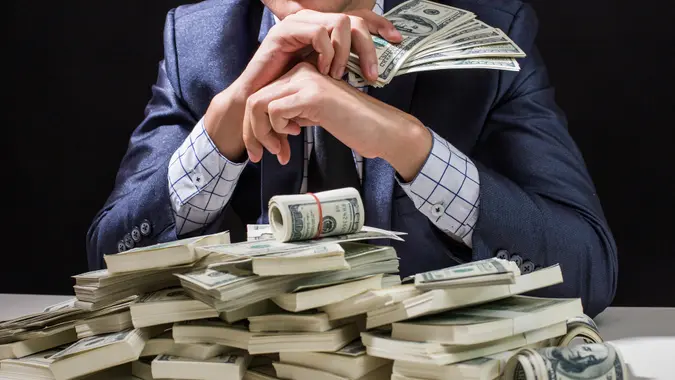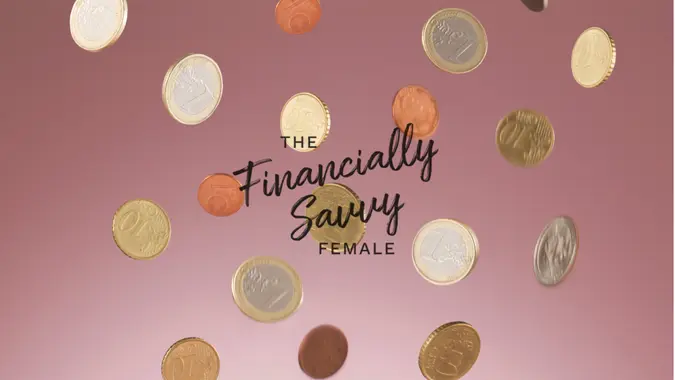What Makes a Rare Coin Worth Up To $19 Million?

Commitment to Our Readers
GOBankingRates' editorial team is committed to bringing you unbiased reviews and information. We use data-driven methodologies to evaluate financial products and services - our reviews and ratings are not influenced by advertisers. You can read more about our editorial guidelines and our products and services review methodology.

20 Years
Helping You Live Richer

Reviewed
by Experts

Trusted by
Millions of Readers
There’s an old saying about not taking any wooden nickels — but what if it was actually a dime, and what if that was worth millions of dollars? Of course, the proverbial wooden nickel isn’t worth a shiny penny, but there are some rare coins out there that are worth more than just their face value.
Lots of times, currency in regular rotation, like a quarter, could be worth upward of $2,000. You just have to know what you’re looking for and what variables and design flaws make each rare coin worth some big bucks.
Often the most expensive and rare coins sold at auction come with the best backstory. For example, the 500,000 1933-dated Double Eagles ($20 denomination U.S. gold coins) that were struck, then subsequently melted when gold was recalled by President Franklin D. Roosevelt.
Because the coins technically weren’t officially released, the small number of coins that escaped the Mint were declared illegal to own and most were confiscated which ultimately upped their allure and value. It wasn’t until the 1990s where one was confiscated by the Secret Service and declared the only legal example that could be owned as a result of a legal battle. This particular coin formerly sold at an auction in 2022 for almost $19 million.
So as you dig through your pockets, break open your piggy bank, search under couch cushions and go through the storage closet searching for coinage, keep some things in mind so that you don’t miss out on cents that could be worth big bucks.
Metal Content
For a rare coin to hold a higher price value than the number we normally assign it, the metal contents have to be either precious or base. Simply put, coins made from precious metals like gold, silver and platinum are often more valuable due to the intrinsic value of the metal itself. For instance, the American Eagle gold bullion coin can be worth upwards of $4,000 in some cases.
Coins minted from base metals like copper or nickel can also increase in value if the metal content becomes more valuable. For example, the 1943 Copper Lincoln Cent is made from copper due to a minting error, and today can be valued between $240,000 and $336,000 whereas the 1943-D copper penny is held in a long-term collection and carries an estimated value of over $1 million.
Age
The age of an old coin can play a significant part in its value. Typically, older coins are harder to find in good condition, becoming rarer and rarer with each passing day. Take the 1794 Flowing Hair Silver Dollar as an example, as it is one of the first silver dollars minted by the United States and was sold for over $10 million in 2013. There is even one in current circulation selling in eBay for $220,500.
This is where age becomes quite a factor in valuation as coins minted during specific historical periods or events can carry added value, as they provide insight into the past and may have a limited supply. Also, old coins can be harder to find in pristine condition so that only adds to the rarity.
Limited Design
A limited edition of anything will up the price due to the lack of supply and availability. With coins, however, that takes on a whole new process of evaluation. A big factor in limited designs of coins comes down to if they are deemed commemorative, whereby they were made with special significance. Here are some valuable examples:
- The 2009 Ultra High Relief Double Eagle: A limited-issue gold coin featuring a design by Augustus Saint-Gaudens, can be worth over $3,000
- The 1913 Liberty Head Nickel: This has distinct design features or artistic qualities with only five known specimens, and is valued at over $4 million due to its unique design and rarity
Design Flaws
Perfection doesn’t always mean a pretty penny is pricier. In fact, oftentimes if a coin has a design flaw that will only increase its value. For example, the 1955 Double Die Lincoln cent, characterized by a noticeable doubling of the image, is worth anywhere from $1,000 to $85,000.
Minting errors though a costly mistake at first, only to add more value to a coin in the future as coins with unintentional design flaws or errors can become valuable collector’s items due to scarcity and the overall rareness of the find.
Caitlyn Moorhead contributed to the reporting for this article.
More From GOBankingRates
 Written by
Written by  Edited by
Edited by 

























